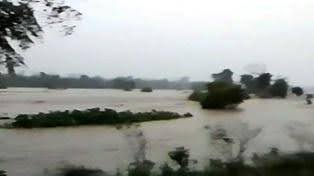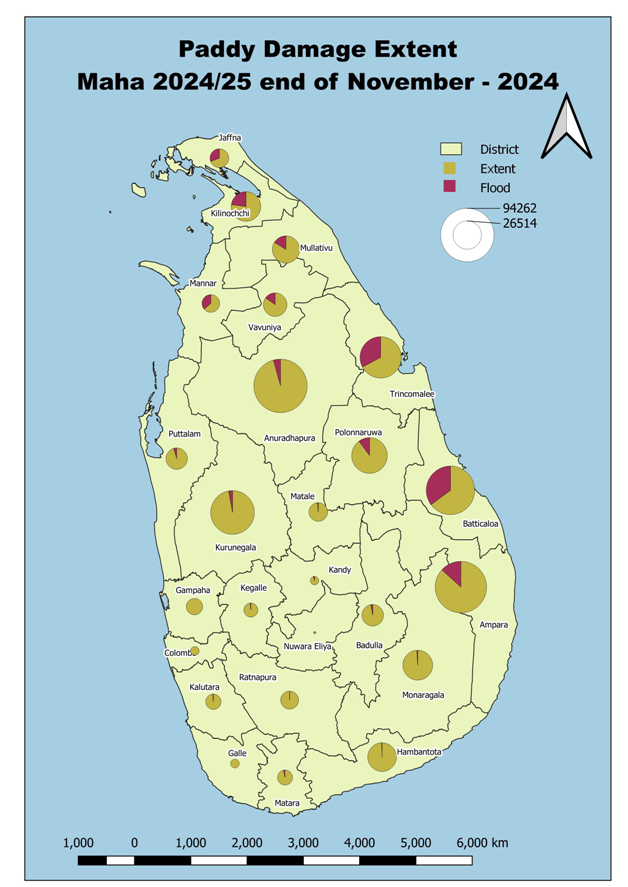Event Overview
Date: 23/11/24
At the end of 2024, Sri Lanka experienced unusually heavy rainfall, which began around November 23, 2024. The primary cause was a deep depression in the Bay of Bengal, which intensified into a cyclonic storm. Heavy rainfall caused by the cyclone was exacerbated by the ongoing monsoon season, which also brings its own heavy rainfall to the region, and the situation worsened significantly towards the end of November and early December. The flooding that inevitably followed resulted in fatalities, injuries, and displacement of a large number of people.
Hazard: Flood Cause: Cyclone
Paddy Lost: 360,000 tonnes Damaged area: 125,000 ha
Impact to Rice Farms
Resilience Constellation has recently been surveying rice (or paddy) farms across the island to gather data for our 2024 Climate Resilience Rating report. These surveys were carried out by field manager Jayamini Samarakoon between August and November 2024. Paddy fields are located in low lying areas next to natural water courses and irrigation channels, meaning they are particularly exposed to flood risk. We asked him to find out what had happened on the farms he had visited.
It turns out that the flooding has caused very significant damage to the rice crops across much of Sri Lanka. Northern, eastern, and central provinces were particularly affected. The rice planting for the Maha (rainy) season was well under way at the end of November. Around 663,000 ha of paddy fields had already been established, around 78% achievement of the national target.
It has now emerged around 125,000 ha had been damaged, of which 80,000 ha have been completely destroyed, according to research by the Faculty of Agriculture of the University of Peradeniya. Reservoirs have overspilled, rivers have burst their banks and irrigation canals breached. As a result, rice crops have been washed away by the flood or drowned (plants cannot survive complete submergence for long). It is estimated that about 360,000 tonnes of paddy have been lost.
Follow-up conversations with the rice farmers that participated in our survey have provided valuable insights into the flood’s impact. While not all have been affected, the damage that some farmers have suffered has been catastrophic.
Information gathered from affected farms
Including images that farmers have shared with us:
Location: Maraka, near the Mahaweli River (eastern edge of Central Province) and Seruditiya, on the other side of the river (south-western corner of Eastern Province)
The paddy farms surveyed in this area were damaged due to the opening of the sluice gates of the Ulhitiya and Rathkinda reservoirs and the overflow of the Kuda Oya. In this area, it is estimated that a total of nearly 50% of paddy fields have been damaged.

Complete inundation of large areas of paddy fields

Flood damage and siltation after the flood waters have receded
Photos courtesy of Mr. A.G. Chandrasena

Flood erosion of bunds around rice fields

Deposition of sand and silt on paddy fields

Extensive deposition of river sediment alongside a damaged irrigation canal
Photos courtesy of Mr. N.G. Gnanathilaka
Location: Nainakadu, located between Ampara and the coast, in the southern part of Eastern Province
The paddy farmers surveyed were not the only ones to suffer in the Ampara district. Many paddy fields have been damaged due to the overflow of the Ampara and the Kondawatuwana Reservoirs. About 14,000 ha of paddy fields cultivated under the Ampara/ Gal Oya project this year have been affected.

Crops flattened after submergence

Large areas of paddy have been affected
Photos courtesy of Mr. A.L. Gafoor
Location: Pahala Talawa, near Talawa, North Central Province
Fortunately, the reports from farmers in the North Central Province, where our survey took place, indicate less serious damage.


Localised damage due to flooding
Photos courtesy of Mr. R. Palihakkara and Mr. Sena Bandara
However, further north in the Northern Provence, there has been serious damage to paddy fields in areas around Mannar, Trincomalee, Jaffna and Kilinochchi, with 56%, 48%, 44% and 30% respectively of planted areas affected.
Location: Matuwagala, near Idangoda, Sabaragamuwa Province
Rice farmers that we surveyed in areas in the south-west of Sri Lanka were also adversely affected. This area is more used to dealing with heavy rain but recent downpours were too much for the waterways to handle.

Rice plants completely submerged
Photo courtesy of Mr D.R.N. Jayasooriya
The map below shows the extent of planted areas by district and the proportion of paddy fields damaged by flooding for the whole of Sri Lanka. Note that the extent of the damage may be worse than shown here, as the heavy rain continued into early December. Unseasonally wet conditions still prevail in Ampara district (January 2025).

Courtesy of Dr. Palitha Dharmawardhana, Faculty of Agriculture, University of Peradeniya
Challenges and Recovery for Rice Farmers
The farmers affected by the floods now face a very difficult time. The short-term challenge is to clear the sandy sediment from the paddy fields and replant the damaged crops as quickly as possible. However, neither task is easy.
The sand covers whole fields in some areas and will need to be shifted manually in most cases, as farmers lack the machinery. On some farms this will be a huge undertaking as the sand may be up 2-3 feet in depth. Finding sufficient seed rice for such a large replanting effort will also be difficult. In order to complete a harvest before the end of the growing season, it would be advantageous to use one of the quicker-growing rice varieties, which mature in 3 rather than 3.5 months, so that the crops can be gathered before the onset of inter-monsoon rains. However, there is simply not enough seed rice available to cover such large areas. Farmers will need to use their own rice stores, which have been put aside for personal consumption, as the source of seed.
The Ministry of Agriculture, Livestock, Land and Irrigation has recently announced that support will be provided, but this is unlikely to cover all the costs of the farmers.
Recent climate trends indicate an increasing frequency of flooding of paddy fields in Sri Lanka and it appears that these floods are not a one-off event. Some of the long-term solutions to deal with periods of prolonged, intense rain require substantial investment. Improvement of irrigation infrastructure to reduce breaches of irrigation canals and overflow of tanks is a high priority.
However, there may be more that farmers can do to stabilise the bunds around their paddy fields by planting productive shrub or tree species. Possible options include Bamboo (Bambusa spp.), Rattan (Calamus spp.), Matgrass (Cyperus pangorei) or edible plants such as Kohila (Lasia spinosa) or Gotukola (Centella asiatica). The shade from taller plants may compromise rice production along field edges, but the benefits in areas at risk of flooding may outweigh the costs.
Satellite monitoring
The extent of damage from climate hazards can be mapped by combining on-ground assessments with advanced satellite technology. Satellite imagery facilitates the efficient monitoring of large areas, pinpointing vulnerable spots that might be missed by ground surveys alone. This approach enables a detailed assessment of the scale and nature of the damage, as well as the performance of crops over time. It is valuable for prioritising aid and tracking changes in farm resilience. Satellite imagery of recent floods in Sri Lanka were not available for this update, but Resilience Constellation uses satellite and derived data in its farm monitoring activities.
Conclusion
The impact of the November 2024 floods on Sri Lankan paddy fields underscores the need for climate resilient solutions and ongoing monitoring, especially as climate change increases the frequency of such events. By revisiting the farms surveyed for our Climate Resilience Rating Reports we gain a comprehensive understanding of the impacts of climate events on these farms which informs the effectiveness of adaptation and resilience efforts.
More information on measures to improve resilience of rice farms to flooding in Sri Lanka can be found in our Climate resilience rating report: Rice Farms in Sri Lanka
Resilience Constellation
Contact us to learn more about how Resilience Constellation can help improve the resilience of the agricultural areas you support, through ongoing monitoring and resilience assessments.
